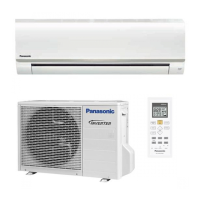Why does my Panasonic CU-Z35VKR Air Conditioner outdoor unit emit water or steam?
- KKimberly ShawSep 12, 2025
The emission of water or steam from the outdoor unit is due to condensation or evaporation occurring on the pipes.

Why does my Panasonic CU-Z35VKR Air Conditioner outdoor unit emit water or steam?
The emission of water or steam from the outdoor unit is due to condensation or evaporation occurring on the pipes.
Why is there discoloration of some plastic parts on my Panasonic CU-Z35VKR?
Discoloration is subject to the material types used in plastic parts, accelerated when exposed to heat, sunlight, UV light, or environmental factors.
Why does the indoor fan stop sometimes during heating with my Panasonic CU-Z35VKR Air Conditioner?
The indoor fan stops occasionally during heating operation to avoid unintended cooling effect.
| Cooling Capacity | 3.5 kW |
|---|---|
| Heating Capacity | 4.0 kW |
| Power Supply | 220-240V, 50Hz |
| Refrigerant | R32 |
| Indoor Unit Dimensions (H x W x D) | 295 x 800 x 223 mm |
Step-by-step instructions for installing batteries in the remote control.
Guide on how to set the current time on the remote control unit.
How to choose desired modes like AUTO, HEAT, COOL, and DRY.
Instructions for setting temperature and switching between Celsius and Fahrenheit.
Covers essential warnings for units, power, remote, and flammable refrigerants.
Guidelines for safe installation, servicing, and refrigerant handling procedures.
Procedures for detecting refrigerant leaks and safe recovery practices.
Instructions for adjusting airflow direction and fan speed.
Guide to MILD DRY, ECO, i AUTO-X, nanoe X, and timer functions.
In-depth explanations of various operation modes and their features.
Instructions for cleaning the unit components and air filters.
Identifying normal operations and performing initial checks before service calls.
Troubleshooting common problems with the remote and the air conditioner unit.
Steps to retrieve diagnostic error codes for effective issue resolution.
Information regarding the collection and disposal of old equipment and batteries.
Explanation of symbols used in the manual for refrigerant and service.












